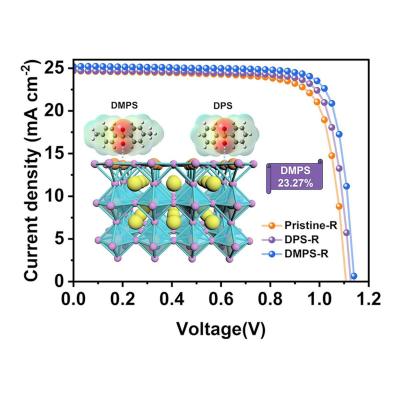Researchers from Zhejiang University of Technology and King Abdullah University of Science and Technology (KAUST) have utilized two sulfone-based organic molecules known as diphenylsulfone (DPS) and 4,4′-dimethyldiphenylsulfone (DMPS) to passivate absorber defects in perovskite solar cells and improve their performance. As a result, the team reported a device with a higher electron cloud density at the interface between the perovskite material and the passivation layer.
The scientists used the molecules to improve charge distribution at the interface between the cell's perovskite absorber and the passivation layer, which reportedly creates electron-rich systems on the surface of perovskite. Using density functional theory (DFT) to compute a wide variety of properties of almost any kind of atomic system, they simulated the charge density distributions of the interactions of DPS and DMPS with formamidinium lead iodide (FAPbI3) perovskite material.
In their study, the scientists explained that the higher electron cloud density they found in DMPS creates a stronger bond of this material with the perovskite absorber, which results in an improved cell stability. They also said that the electronic-rich environment provided by DPS and DMPS reduces the positive charge of lead (Pb) in the perovskite absorber, which contributes to increased electron cloud density.
“These results indicate that the uncoordinated Pb2+ ions on the surface of the perovskite film were effectively passivated by the small molecules, suggesting the improved performance and stability of the cell,” the team explained, noting that these results were confirmed by further analysis conducted via X-ray diffraction (XRD), scanning electron microscopy (SEM), atomic force microscopy (AFM).
The proposed approach was also tested through the construction of a physical cell treated with DMPS and consisting of a substrate made of glass and indium tin oxide (ITO), a tin oxide (SnO2) electron transport layer (ETL), the cadmium-doped FAPbI3 absorber, a hole transport layer based on Spiro-OMeTAD, and a silver (Ag) metal contact. “An investigation into the effect of treatment concentration on the device performance revealed a significant enhancement in the photovoltaic performance at concentrations of 1 and 3 mg mL−1 for DPS and DMPS, respectively,” the scientists said.
The cell achieved a power conversion efficiency of 23.27%, an open-circuit voltage of 1.141 V, a short-circuit current density of 25.21 mA cm−2, and a fill factor of 80.93%. The device was also found to retain 92.5% of its initial efficiency after 1,000 h. “The efficiency of devices treated with DMPS increased from the original 21.21% to 23.27%,” the team said, noting that reference devices built without DMPS and DPS treatment achieved considerably lower results.
“The surface passivation strategy employing efficient organic conjugated small molecules provides a novel approach to enhance the photovoltaic performance of perovskite solar cells, the researchers concluded.




